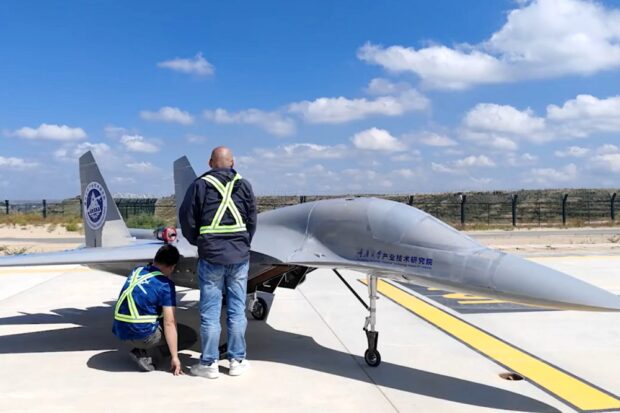A joint venture between Chongqing University Industrial Technology Research Institute and the Shenzhen-based private company Thrust-to-Weight Ratio Engine (TWR) has successfully tested a new rotating detonation engine (RDE) propelled drone. Conducted at an undisclosed location in Gansu province, China, reports the South China Morning Post (SCMP), the RDE-engined drone could open the door for future drones with unparalleled speeds.
Super Fast Drones
Little concrete details are available beyond released images of the drone’s FB-1 Rotating Detonation Engine (FB-1 RDE) ignition during taxiing. It is also unclear if the 16-foot (5-meter) drone could take off and fly for an extended period using the engine. However, Chongqing Morning News reported that the test did, indeed, include the drone’s maiden flight.
The basic concept of an RDE is a detonation wave that travels around a circular channel (annulus). Fuel and oxidizer are injected into the channel through small holes or slits. A detonation is initiated in the fuel/oxidizer mixture by some form of igniter. After the engine is started, the detonations are self-sustaining. In turn, the combustion products expand out of the channel and are pushed out by the incoming fuel and oxidizer.
While ostensibly similar to pulse detonation engines (PDE) as seen in German V1 “Doodlebug” flying bombs during WW2, RDEs eliminate the need for purging after each pulse. If ever fully developed, such engines could lead to significant fuel savings. However, RDEs suffer from instability and are very loud compared to other forms of aerospace engines.
According to news reports from China, the RDE engine had already undergone multiple ground tests before it was attached to the drone for its first flight.
“It uses kerosene fuel and features rapid ignition, and could power an aircraft from zero-speed to several times the speed of sound,” reported Chongqing Morning News.
Existing engines struggle to reach speeds multiple times the speed of sound due to inherent issues. Traditional turbojet engines, for example, use fan blades to draw air into the engine, which causes drag at speeds above Mach 3. Other promising options, like ramjet engines, can surpass Mach 3 by compressing incoming air with its unique shape. However, such engines do not provide improved combustion efficiency; they also require high initial speeds (ideally Mach 0.5).
For this reason, an RDE engine is believed to be a more effective alternative to turbojet and ramjet engines, and they have the potential to revolutionize supersonic flights with less fuel consumption. Other options, like scramjet engines, are also great but require speeds above Mach 4 to initiate. The RDE, the other hand, can start from 0 mph (0 kph) and is said to be easier to maintain.
But RDEs are not without their issue, too. For example, the internal walls of the engine must withstand constant shock waves, requiring high standards in structural integrity and material strength.
Could Prove Revolutionary
“This recent development marks a crucial step in TWR’s integrated strategy for advancing detonation engine and detonation-powered flight technologies,”
said TWR in a press release on Wednesday (September 20, 2023).
If news about the successful test is genuine, it could have far-reaching impacts on various applications, such as commercial space rockets, high-speed drones, military aircraft, and guided missiles.
Source: Interesting Engineering

